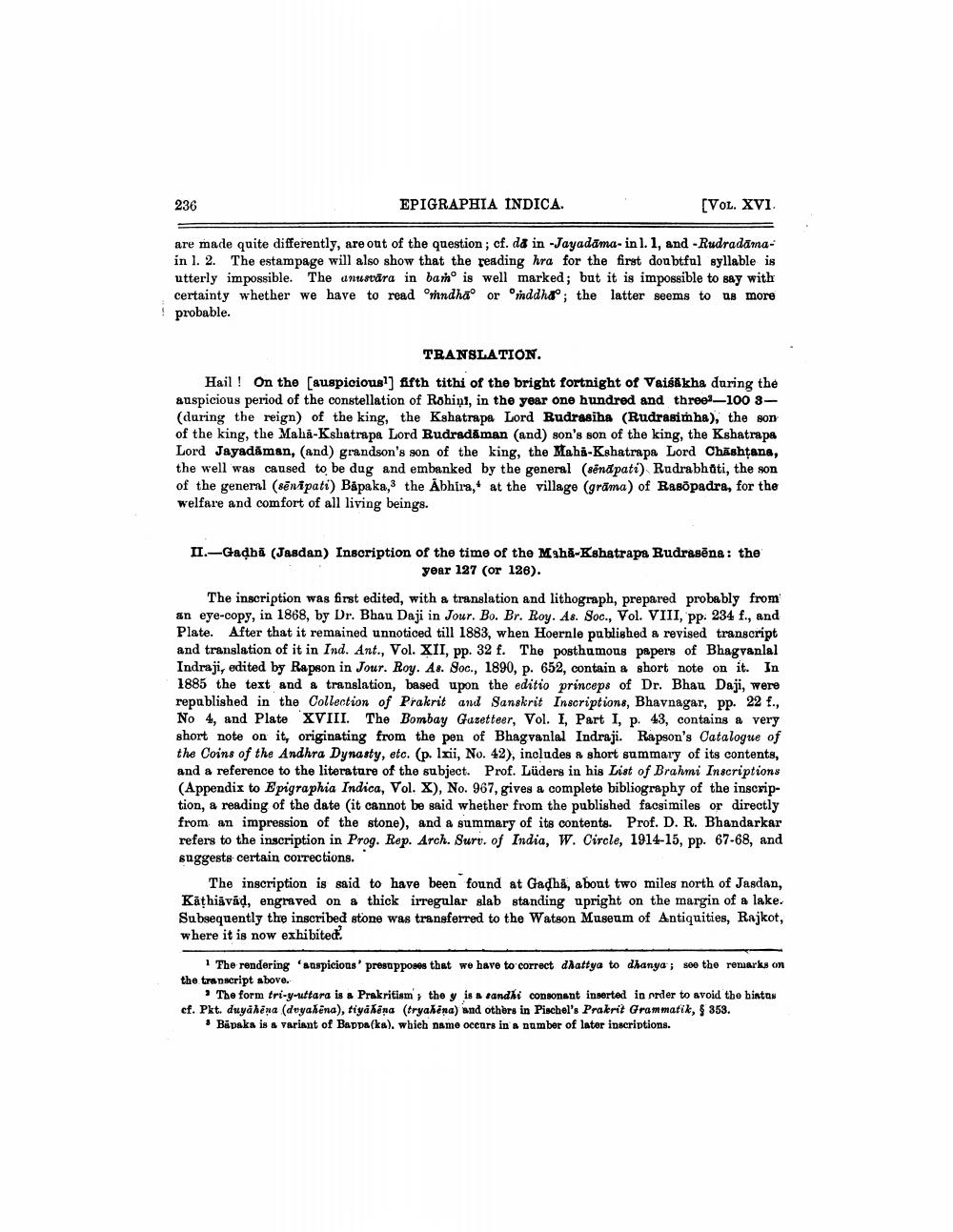________________
236
EPIGRAPHIA INDICA.
[VOL. XVI
are made quite differently, are out of the question; cf. da in -Jayadāma-in l. 1, and - Rudradānain l. 2. The estampage will also show that the reading hra for the first doubtful syllable is utterly impossible. The unustāra in baro is well marked; but it is impossible to say with certainty whether we have to read Orndha or iddhao; the latter seems to us more probable.
TRANSLATION. Hail ! On the [auspicious!] fifth tithi of the bright fortnight of Vaisikha during the auspicious period of the constellation of Rohiņi, in the year one hundred and threes-100 8(during the reign) of the king, the Kshatrapa Lord Rudrasiha (Rudrasimha), the son of the king, the Maha-Kshatrapa Lord Rudradāman (and) son's son of the king, the Kshatrapa Lord Jayadāman, (and) grandson's son of the king, the Mahi-Kshatrapa Lord Chashtana, the well was caused to be dug and embanked by the general (sêndpati) Rudrabhati, the son of the general (sēnipati) Bapaka, the Abhira,+ at the village (grāma) of Rasõpadra, for the welfare and comfort of all living beings.
II.--Gadhi (Jasdan) Inscription of the time of the Mah.-Kshatrapa Rudrasēna: the
year 127 (or 126). The inscription was first edited, with a translation and lithograph, prepared probably from an eye-copy, in 1868, by Dr. Bhau Daji in Jour. Bo. Br. Roy. As. Soc., Vol. VIII, pp. 234 f., and Plate. After that it remained unnoticed till 1883, when Hoernle published a revised transcript and translation of it in Ind. Ant., Vol. XII, pp. 32 f. The posthamous papers of Bhagvanlal Indraji, edited by Rapson in Jour. Roy. As. Soc., 1890, p. 652, contain a short note on it. In 1885 the text and a translation, based upon the editio princeps of Dr. Bhau Daji, were republished in the Collection of Prakrit and Sanskrit Inscriptions, Bhavnagar, pp. 22 f., No 4, and Plate XVIII. The Bombay Gazetteer, Vol. I, Part I, p. 43, contains a very short note on it, originating from the pen of Bhagvanlal Indraji. Rapson's Catalogue of the Coins of the Andhra Dynasty, etc. (p. lxii, No. 42), includes a short summary of its contents, and a reference to the literature of the subject. Prof. Lüders in his List of Brahmi Inscriptions (Appendix to Epigraphia Indica, Vol. X), No. 967, gives a complete bibliography of the inscription, a reading of the date (it cannot be said whether from the published facsimiles or directly from an impression of the stone), and a summary of its contents. Prof. D. R. Bhandarkar refers to the inscription in Prog. Rep. Arch. Surv. of India, w. Circle, 1914-15, pp. 67-68, and suggests certain corrections.
The inscription is said to have been found at Gadha, about two miles north of Jasdan, Kāhiavad, engraved on a thick irregular slab standing upright on the margin of a lake. Subsequently the inscribed stone was transferred to the Watson Museum of Antiquities, Rajkot, where it is now exhibited.
The rendering 'auspicions' presupposes that we have to correct dhattya to dhanya ; see the remarks on the transcript above.
The form tri-y-uttara is a Prakritism, the y is a sandhi consonant inserted in order to avoid the bintas cf. Pkt. duyahēna (duyahena), tiyakana (tryahena) and others in Pischel's Prakrit Grammatik, $ 353.
Bapaka is a variant of Bappa(ka), which name occars in a number of later inscriptions.




